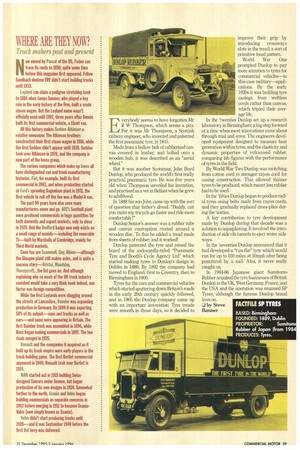WHERE ARE THE NOW?
Page 61

If you've noticed an error in this article please click here to report it so we can fix it.
Truck makers past and present Truck makers past and present
No. owned by Paccar of the US, Foden can trace its roots to 1856; quite some time before this magazine first appeared. Fellow San dbach denizen ERF didn't start building trucks until 1933.
Leyland can claim a pedigree stretching back to 1884 when James Sumner, who played a key role in the early history of the firm, built a crude steam wagon. But the Leyland name wasn't officially used until 1907, three years after Dennis built its first commercial vehicle, a 15cwf van.
All this history makes Seddon Atkinson a relative newcomer. The Atkinson brothers constructed their first steam wagon in 1916, while the first Seddon didn't appear until 1938. Seddon took over Atkinson in 1970, and the company is now part of the Iveco group.
The various companies which make up Iveco all have distinguished van and truck manufacturing histories. Fiat, for example, built its first commercial in 1903, and when production started at Ford's sprawling Dagenham plant in 1931, the first vehicle to roll off the line was a Model A van.
The past 90 years have also seen many manufacturers come and go. AEC's Southall plant once produced commercials ifl huge quantities for both domestic and export markets, only to close in 1979. And the Bedford badge now only exists on a small range of models—including the venerable Ti—built by Marshalls of Cambridge, mainly for Third World markets.
Gone too are Scannell, Guy, Albion—although the Glasgow plant still makes axles, and is quite a success story—Bristol, Maudslay, Tliornycroft...the list goes on. And although explaining why so much of the UK truck industry vanished would take a very thick book indeed, one factor was foreign competition.
While the first Leylands were chugging around the streets of Lancashire, Daimler was expanding production in Germany. By 1899 it was exporting 50% of its output—vans and trucks as well as cars—and some were appearing in Britain. The first Daimler truck was assembled in 1896, while Benz began making commercials in 1897. The two rivals merged in 1925.
Renault and the companies it acquired as it built up its truck empire were early players in the truck-building game. The first Berliet commercial appeared in 1906; Renault took over Berliet in 1974.
MAN started out in 1915 building Swissdesigned Saurers under licence, but began production of its own designs in 1924. Somewhat further to the north, Scania and Vabis began building commercials as separate concerns in 1902 before merging in 1911 to become ScaniaVabis (now simply known as Scania).
Volvo didn't start producing trucks until 1928—and it was September 1949 before the first Daf lorry was delivered. Fi verybody seems to have forgotten Mr R W Thompson, which seems a pity.
For it was Mr Thompson, a Scottish railway engineer, who invented and patented the first pneumatic tyre, in 1845.
Made from a hollow belt of rubberised canvas covered in leather, and bolted onto a wooden hub, it was described as an "aerial wheel."
But it was another Scotsman, John Boyd Dunlop, who produced the world's first really practical pneumatic tyre. He was five years old when Thompson unveiled his invention, and practised as a vet in Belfast when he grew to adulthood.
In 1888 his son John came up with the sort of question that father's dread. "Daddy, can you make my tricycle go faster and ride more comfortably?"
Dunlop Senior's answer was a rubber tube and canvas contraption riveted around a wooden disc. To this he added a tread made from sheets of rubber; and it worked!
Dunlop patented the tyre and joined the board of the awkwardly-titled "Pneumatic Tyre and Booth's Cycle Agency Ltd" which started making tyres to Dunlop's design in Dublin in 1889. By 1892 the company had moved to England, first to Coventry, then to Birmingham in 1900.
Tyres for the cars and commercial vehicles which started sputtering down Britain's roads in the early 20th century quickly followed, and in 1905 the Dunlop company came up with an important innovation. Tyre treads were smooth in those days, so it decided to
improve their grip by introducing crossways slots in the tread; a sort of primitive tread pattern.
World War One prompted Dunlop to pay more attention to tyres for commercial vehicles—in this case military—applications. By the early 1920s it was building tyre casings from weftless cords rather than canvas, which tripled their average life.
In the 'twenties Dunlop set up a research laboratory in Birmingham; a big step forward at a time when most innovations came about through trial and error. The engineers developed equipment designed to measure heat generation within tyres, and the elasticity and dynamic properties of vulcanised rubber, comparing lab figures with the performance of tyres in the field.
By World War Two Dunlop was switching from cotton cord to stronger rayon cord for casing construction. This allowed thinner tyres to be produced, which meant less rubber had to be used.
In the 'fifties Dunlop began to produce radial tyres using belts made from rayon cords, and they gradually replaced cross-plies during the 'sixties.
A key contribution to tyre development made by Dunlop during that decade was a solution to aquaplaning. It involved the introduction of side rib tunnels to eject water sideways.
In the 'seventies Dunlop announced that it had developed a "run flat" tyre which would run for up to 100 miles at 50mph after being punctured by a nail. Alas, it never really caught on.
In 1984-86 Japanese giant Sumitomo Rubber acquired the tyre businesses of British Dunlop in the UK, West Germany, France, and the USA and the operation was renamed SP Tyres, although the famous Dunlop brand lives on. ZI by Steve Banner BASED: Birmingham FACTFILE SP TYRES




























































































































